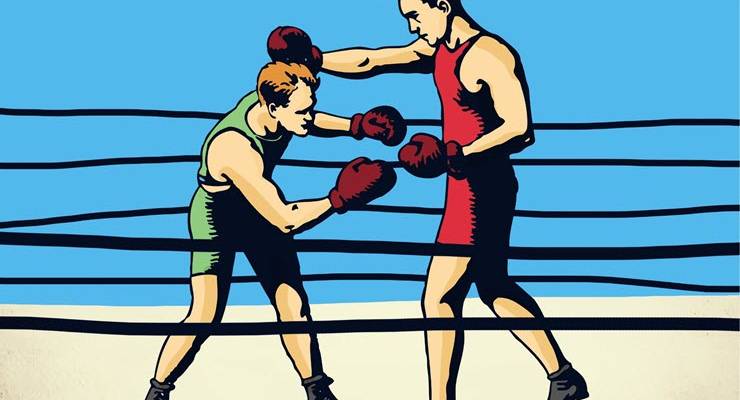
In boxing, everything has its price: it’s not called prize fighting for nothing. Leaving aside the amateurs, boxing has always been about people fighting for money. But where does it all come from?
The fight game’s first source of funds was gambling. In its simplicity, a boxing match almost cries out to be bet on. History does not relate whether the Sumerians were throwing down a few clay tokens on their favourite fighters, but I’d wager they were. What’s certain is that gambling was present at the start of boxing’s modern history in 18th-century London. In fact, it’s not all that much of a stretch to suggest that fist fighting was codified as a sport because the workers who flooded into the English capital from the countryside didn’t have space for traditional rural amusements and needed something new to bet on.
In the financial, as in the physical, side of the sport, John L. Sullivan, the first gloved champion, was a bridge from the bare-knuckle era to something that more closely resembles modern boxing. “The Boston Strong Boy”, one of America’s first true celebrities, pioneered moneymaking strategies still familiar today, including endorsements — Sullivan backed everything from beef stock to boxing gloves — and acting. Even more significantly, he helped move the sport out of the literal backwoods and into the electrically lit arenas of modern cities, close to its natural fan base, the industrial working class.
This was crucial, as it allowed promoters to more easily charge for entry. Tickets for Sullivan’s 1892 fight with “Gentleman Jim” Corbett at a specially-built auditorium in New Orleans were priced between five and 15 dollars, and 10,000 punters paid for the privilege of seeing the heavyweight championship change hands for the first time. Within a few short years, the revenue from ticket sales had supplanted the need for fighters to put up their own stakes.
When Jack Johnson fought Jim Jeffries in their 1910 fight of the century, the pair also made a tidy profit by selling the rights to film the bout. By the time the pair met in Reno, boxing films were already a thriving industry. In fact, in Boxing, A Cultural History, Kasia Boddy contends that boxing was a key driver of the development of motion pictures as a medium. Boxing, with its confined action, was a perfect subject for film pioneers, whose cameras were large and immobile. It was also a guaranteed success at the box office.
The combination of film, ticket sales and the rise of mass media combined to turn boxing into a truly enormous business. But boxing, with its huge popularity, also shaped the modern media landscape.
The next “fight of the century” (there would be many), Jack Dempsey’s 1921 clash with the French war hero Georges Carpentier at Boyle’s Forty Acres outside Jersey City, is best known for being the first ever million-dollar gate, with $1.7 million in tickets sold. But perhaps more significantly, it was the first major sporting event ever broadcast live to a mass audience. When the depression hit, it swelled the ranks of boxers at the same time as severely cutting down the prizes they were fighting for. But it was also a period when broadcast technology matured.
Like Sullivan before him, Joe Louis was a bridge between two periods: the radio era and that of television. All Louis’ major fights were broadcast on the radio, which by the mid-1930s had entered American homes. An estimated 70 million people tuned in to hear his 1938 knockout of Nazi Germany’s Max Schmeling.
As with film, boxing was perfect for the static TV cameras of the day, plus there were built-in breaks for selling beer and razor blades. By the mid-1950s, Americans could watch fights on network television up to six nights a week.
Louis’ 1946 rematch with Billy Conn was the first televised heavyweight title fight, though the technology was still in its infancy. Five years later, Louis’ loss to Rocky Marciano was perfectly timed for the arrival of TV sets in homes. The event was seen as so crucial for the burgeoning industry that a consortium of television manufacturers clubbed together with Gillette, a major advertiser, to purchase the rights to a free-to-air broadcast for more than $100,000. It’s estimated that more than 80% of America’s 30 million television sets tuned in to watch Louis’ sad farewell.
For the biggest fights, closed-circuit television provided another possible income source. Closed-circuit transmitted footage to cinemas full of ticketholders via specially built telephone lines. In the early 1950s, home television and closed-circuit engaged in a now largely forgotten format war. Closed-circuit eventually proved to be a much better economic proposition for boxers, and by the mid-1950s the closed-circuit theatre system could seat half a million patrons across the United States and Canada.
In 1971, Ali’s first fight with Frazier (another fight of the century, for those playing at home) drew most of its record $30 million in takings from a global closed-circuit audience of 300 million.
Pay-per-view is essentially a technological update on closed-circuit, allowing viewers to pay for fights without leaving the house. In boxing, now as ever, everything has its price.
This is an edited extract from Alex McClintock’s debut book, On The Chin: A Boxing Education, published by Text Publishing, out now.







The Johnson/Burns fight in Sydney (Boxing Day 1908) was also part financed by the film made of it, much of which survives.
Be interesting to know if it was the first to be financed this way, it was certainly the ‘fight of the century’ in Australia, indeed probably the sport event of the century here, given its international fame and repercussions.